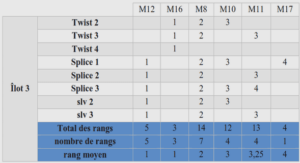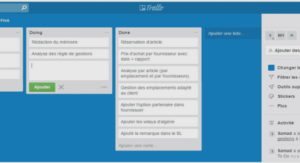ACCELERATED LABORATORY TEST OF BIODETERIORATION
The development of the accelerated laboratory test to study fungal biodeterioration of a cementitious matrix is described in this chapter. Five tests were performed before to define the best methodology. Each test was optimized as a result of the previous one. Therefore, results relating to each test are presented chronologically. Boxes in polypropylene were used for the experimental device (Figure 45). The use of such boxes permits to keep a sterile environment inside it, as they are autoclavable. The experimental device chosen is inspired by the one used in test for wood preservatives involving wood destroying basidiomycetes (NF EN 113). The advantage is that the methodology described was already developed in our laboratory previously. Hence, the procedure was just adapted to our experimental conditions. Stone surfaces will be colonized by micro-organisms if enough humidity and nutrients are available (Kussmaul et al, 1998). For the first test, the idea was that nutritive medium should be brought to trigger and enhance fungal development. The first choice was ported on liquid medium. By this way, the liquid solution could rise continuously by capillarity into the submerged specimens, bringing the humidity for fungal development. Relating to specimens, freshly prepared hydrated cement pastes are characterized by a pH value of 12 or higher. Under such alkaline conditions most micro-organisms are unable to grow (Shirakawa et al, 2003). The progressive carbonation of hydrated cement paste leads to the neutralization of the alkalinity of the water in the matrix pores. This results in a decrease of the surface pH (cf. chap V), thus creating favourable conditions for microbial propagation (Shirakawa et al., 2003). At this stage of the study only carbonation was considered as weathering step. The specimens are sterilized by γ-radiation (30 kGy), which appears to be the most suitable way of sterilization.
Inoculation is performed by means of spores’ suspension spread on the whole specimen surface. This way of inoculation is the most widely reported in literature relating to laboratory tests of biodeterioration involving fungi (Oshima et al, 1999; Shirakawa et al, 2003; de Moraes Pinheiro et al., 2003; Urzì and De Leo, 2007). Therefore, experiments can be easily reproducible as the concentration inoculated is exactly known. From these first observations, it appears that the specimens should not be submerged in liquid medium. In this way, the RH imposed in the culture chamber plus the humidity provided by the presence of liquid medium may result in a too high RH inside the box. Moreover, the specimen may be too damp to trigger an optimal fungal development. These conditions are nearer from culture in liquid medium than one in solid medium. Therefore the experimental conditions withdrew from ones expected.
For this second test, solid nutritive medium covers the box bottom as suggested in NF EN 113. When the spores’ suspension is inoculated on the specimen, it will draw along sides and spill on the solid medium. Fungal development should be faster on the nutritive medium than on the specimen surface. Therefore, the presence of nutritive medium should trigger and enhance fungal growth. Liquid nutritive medium is also spread on the specimen surface. Once it has been absorbed, the specimen is placed vertically in the box, as shown in Figure 46. The suspension of Alternaria alternata’s spores are inoculated on the upper face. This way of inoculation was chosen in order to promote the maximum spreading of spores on the specimen, on the two vertical larger sides. After two months of incubation, the entire solid nutritive medium is covered by Alternaria alternata. A progressive covering of the specimen was expected at the bottom from the fungal development on the solid nutritive medium, and on the upper face from the germination of spores inoculated. However, no fungal development is noted on the non weathered and the carbonated specimen. The dark colour observed on the specimen surface (Figure 47) corresponds to the spores inoculated and not at all to the fungal development.



